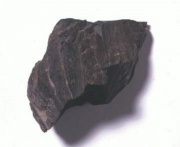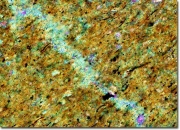Difference between revisions of "Shale"
(username removed) |
|||
| (2 intermediate revisions by one other user not shown) | |||
| Line 2: | Line 2: | ||
== Description == | == Description == | ||
| − | An abundant sedimentary rock consolidated from layers of [ | + | An abundant [[sedimentary]] rock consolidated from layers of [[clay|clay]] and [[mud|mud]]. Shale has very fine grains and a laminated structure that fractures easily along the bedding lines. The stone is soft, smooth, and can feel greasy. Shale is composed of clay (>30%) and [[silica|silica]] along with smaller quantities of carbonates, feldspars, iron oxides, fossils, and organic matter (called shale oil). Shale oil, or kerogen, is a sulfurous hydrocarbon that can be refined as a source of fuel. Shale can vary in color from gray, brown, black, green, or red. Shale is used in the manufacture of ceramics, tile, and brick. It is also a source of [[alumina|alumina]] for [[portland%20cement|portland cement]]. |
[[File:shalearenaceous1large.jpg|thumb|Shale]] | [[File:shalearenaceous1large.jpg|thumb|Shale]] | ||
| Line 9: | Line 9: | ||
layered mudstone; skifer (Dan.); Schiefer (Deut.); schiste (Fr.); schalie (Ned.); argilito (Port.) | layered mudstone; skifer (Dan.); Schiefer (Deut.); schiste (Fr.); schalie (Ned.); argilito (Port.) | ||
| − | == | + | ==Resources and Citations== |
| − | * ''Encyclopedia Britannica'', http://www.britannica.com Comment: "shale" | + | * ''Encyclopedia Britannica'', http://www.britannica.com Comment: "shale" [Accessed January 22, 2002]. |
* C.W.Chesterman, K.E.Lowe, ''Audubon Society Field Guide to North American Rocks and Minerals'', Alfred A. Knopf, New York, 1979 | * C.W.Chesterman, K.E.Lowe, ''Audubon Society Field Guide to North American Rocks and Minerals'', Alfred A. Knopf, New York, 1979 | ||
| − | * Wikipedia | + | * Wikipedia: http://en.wikipedia.org/wiki/Shale (Accessed Nov. 9, 2005) |
* ''Van Nostrand's Scientific Encyclopedia'', Douglas M. Considine (ed.), Van Nostrand Reinhold, New York, 1976 | * ''Van Nostrand's Scientific Encyclopedia'', Douglas M. Considine (ed.), Van Nostrand Reinhold, New York, 1976 | ||
Latest revision as of 07:27, 28 August 2020
Description
An abundant Sedimentary rock consolidated from layers of Clay and Mud. Shale has very fine grains and a laminated structure that fractures easily along the bedding lines. The stone is soft, smooth, and can feel greasy. Shale is composed of clay (>30%) and Silica along with smaller quantities of carbonates, feldspars, iron oxides, fossils, and organic matter (called shale oil). Shale oil, or kerogen, is a sulfurous hydrocarbon that can be refined as a source of fuel. Shale can vary in color from gray, brown, black, green, or red. Shale is used in the manufacture of ceramics, tile, and brick. It is also a source of Alumina for Portland cement.
Synonyms and Related Terms
layered mudstone; skifer (Dan.); Schiefer (Deut.); schiste (Fr.); schalie (Ned.); argilito (Port.)
Resources and Citations
- Encyclopedia Britannica, http://www.britannica.com Comment: "shale" [Accessed January 22, 2002].
- C.W.Chesterman, K.E.Lowe, Audubon Society Field Guide to North American Rocks and Minerals, Alfred A. Knopf, New York, 1979
- Wikipedia: http://en.wikipedia.org/wiki/Shale (Accessed Nov. 9, 2005)
- Van Nostrand's Scientific Encyclopedia, Douglas M. Considine (ed.), Van Nostrand Reinhold, New York, 1976
- Random House, Webster's Encyclopedic Unabridged Dictionary of the English Language, Grammercy Book, New York, 1997
- The American Heritage Dictionary or Encarta, via Microsoft Bookshelf 98, Microsoft Corp., 1998
- G.S.Brady, Materials Handbook, McGraw-Hill Book Co., New York, 1971 Comment: p. 703

